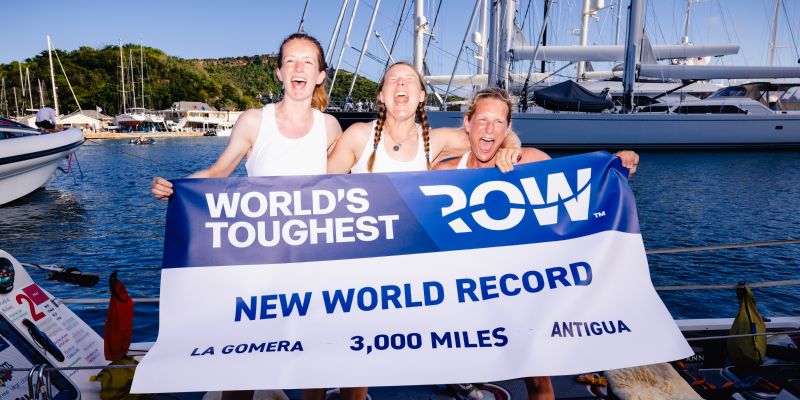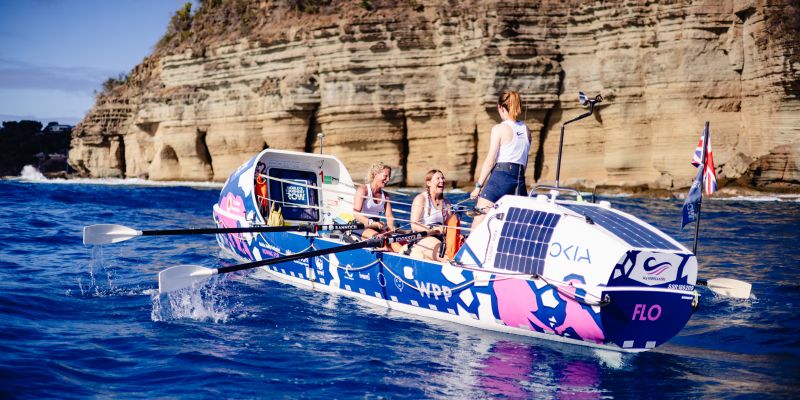
When Hatty Carder was asked to organise a rowing team to race across the Atlantic, she never imagined stepping into the boat herself – let alone setting a new world record.
Marlin are notoriously bad news in the World’s Toughest Row, a 3,000 mile race from La Gomera, Spain to Nelson’s Dockyard, Antigua. The spear-like snout of the giant fish can pierce the bottom of the carbon fibre boat’s hull to reach the deck.
“One of them stalked our boat for a while,” said Hatty (English 2017). “Thankfully a wave seemed to disturb it. But another boat in the race wasn’t so lucky, and the marlin pierced a hole in their boat.”
For an individual who admits to being “a nervous person”, and who first tried their hand at the sport just two years before, a two-month crossing of the Atlantic in an eight-meter rowing boat seems impossible. The race has had fewer finishers than there have been successful summits of Mount Everest.
Yet Hatty and her crewmates Katherine Antrobus and Bobbie Mellor completed the challenge in 40 days, 10 hours and 51 minutes, setting a new world record time for fastest female trio.
They fundraised over £87,000 for WWF and UNHCR’s Climate Crisis Fund, with all donations being matched by the Vodafone Foundation – Hatty’s employer, who initially tasked her with organising a crew for the annual race to raise money and inspire colleagues.
“I love the outdoors, but I’ve never been good at sport,” she says. “My role was to manage the process and interview possible crew members.” Hatty’s strengths lay in fundraising. At Leeds, she was Community Secretary for the hockey club, and raised thousands of pounds in the role. She jokes that on the field, however, she was dropped from the sixth squad to play in the seventh.
But when a crew member dropped out from the rowing trio – who were named Wavebreakers – Hatty was persuaded to give it a try. She passed the physical tests to become part of the crew and joined them for a gruelling training regime. A year of gym work was backed up by weekends out to sea to learn the navigation systems, first aid and other survival skills.

Image credit: World's Toughest Row
Nothing could prepare them for the race itself, as they set out from the start line and onto rough seas. “It’s amazing how quickly we lost sight of competitors,” Hatty said. “Those first 10 days we were met by some huge weather systems.”
Rotating in shifts of three hours rowing, three hours rest, the team contended with 35 knot winds, mountainous waves, baking sunshine and lashing rain. After a night where they had been forced to deploy the para-anchor, a parachute system which ensures stability in rough weather, they were feeling particularly low – when a single wave capsized the boat. “I’ve never seen a wave like it,” Hatty said. “Suddenly we were in the sea. The boat self-righted, but my oar had snapped, and Katherine – who had been asleep in the cabin – suffered a huge black eye.”
Hatty describes her own anxiety as her biggest challenge. “Fear of the waves and capsizing again was a constant battle. I can’t describe the size of some of those waves, and at night you often couldn’t see them coming. By the end my nerves had nothing left.”
Those fears combined with sleep deprivation, constant bruising from the oars, and salt crystals on the skin which could cause painful sores. “I rang the race doctor and explained our ailments. They told me ‘this is not a comfortable sport’. So we began to accept those aches and pains as a part of life. After the first week or so, the body begins to adapt, and we began to move through the field.”
The crew found a rhythm, and leapt from 21st to 10th place, a surge which Hatty puts down to teamwork. Every position gained motivated the crew and boosted their morale, and they managed to maintain their form all the way to Antigua. “We had done personality testing and spoken a lot about how we would work as a team. It made us really strong. It’s a very intense space to be enclosed in but we resolved conflicts and kept each other going.”
Dolphins, whales and flocks of seabirds were regular visitors during the row. When Hatty and the crew jumped into the water to clear barnacles off the bottom of the boat to deter hungry fish – which would have attracted marlins – the rest of the team had to be on lookout for sharks.
“Despite the fears, there were some truly special moments out there. When the sun shone and you were out in the open, it was fantastic. We only became aware of the record once things had started going well, but we had to keep focussed because anything could happen. To actually achieve it really shocked us.”
Now back on solid ground, Hatty explained how she has felt claustrophobic within the confines of the office. Her calf and glute muscles have been depleted from lack of use, so walking has become a challenge. It is a reminder of the scale of the achievement – which is still sinking in.
“But I think it just goes to show that anyone can achieve the extraordinary.”
Further information
Explore some of the images and videos from the Wavebreakers’ journey by visiting their Instagram page.
For further details, email Ed Newbould, Digital Communications Officer, University of Leeds at e.w.newbould@leeds.ac.uk.